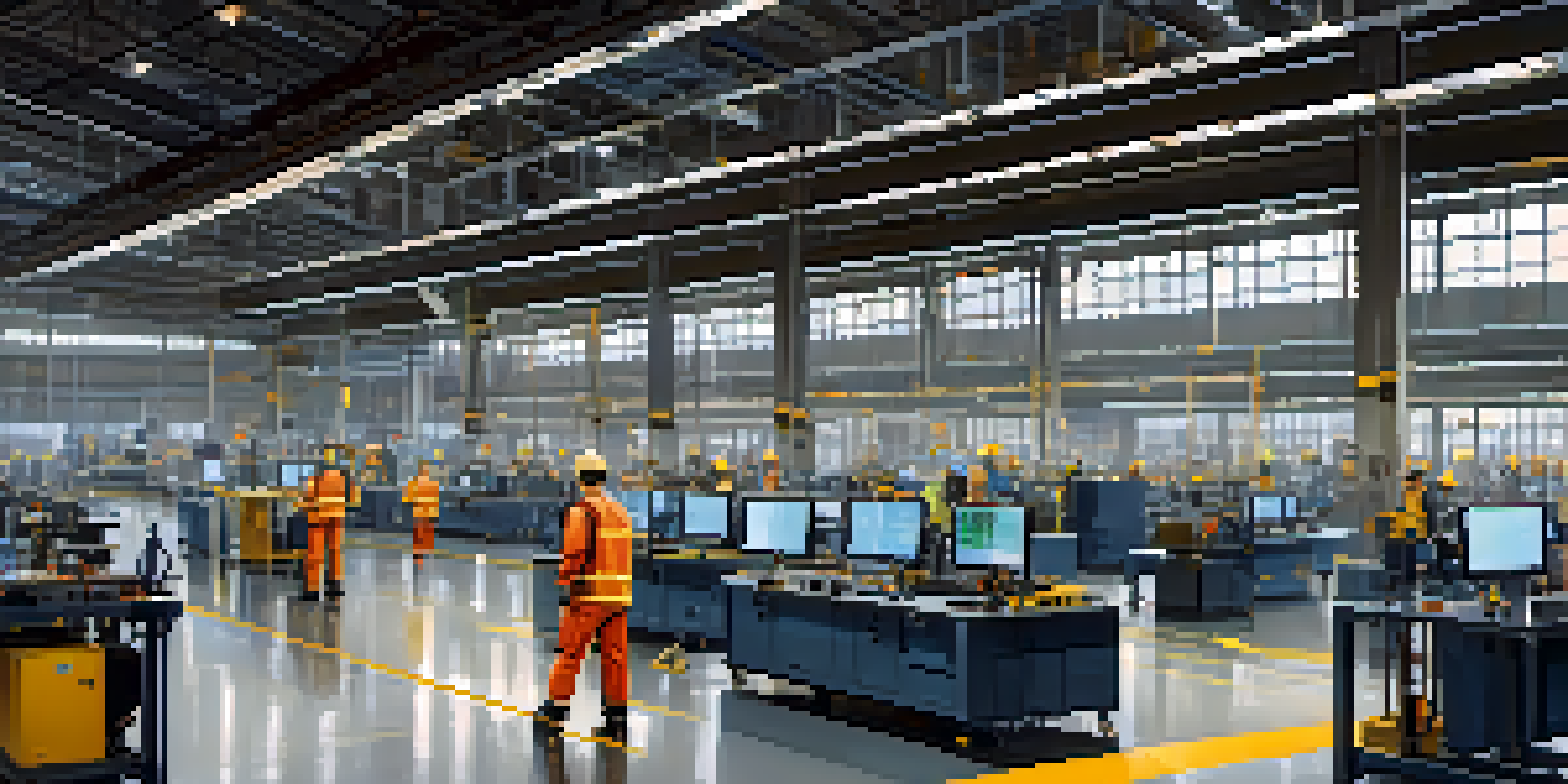How IoT is Enhancing Workplace Safety and Productivity

Understanding IoT: A Game Changer for Workplaces
The Internet of Things (IoT) refers to a network of interconnected devices that communicate and share data. This technology is revolutionizing workplaces by streamlining operations and enhancing safety measures. Imagine a factory floor where machines alert personnel about potential hazards or maintenance needs before they become critical issues.
The Internet of Things is not a trend; it's a transformation.
By integrating IoT devices into everyday operations, companies can monitor various factors such as temperature, humidity, and equipment performance in real-time. This leads to quicker decision-making and improved responses to safety concerns, ultimately fostering a safer working environment. Think of it as having a digital assistant that never sleeps.
Moreover, IoT enables remote monitoring, allowing managers to oversee operations from anywhere. This flexibility not only boosts productivity but also ensures that safety protocols are adhered to even when supervisors are off-site.
Enhancing Worker Safety with IoT Solutions
One of the most significant benefits of IoT in the workplace is its ability to enhance worker safety. Wearable devices equipped with sensors can monitor workers' vital signs and environmental conditions, alerting them to potential dangers. For instance, if a worker is exposed to high levels of toxic gases, the wearable can send an immediate warning.

Additionally, IoT-enabled cameras and sensors can detect unsafe behaviors and conditions, such as improper use of equipment or hazardous spills. This proactive approach allows organizations to address issues before accidents occur, significantly reducing workplace injuries. It's like having an extra set of eyes and ears looking out for the team's well-being.
IoT Enhances Workplace Safety
IoT devices, like wearables and sensors, proactively monitor conditions and behaviors to significantly improve worker safety.
With these systems in place, companies can create a culture of safety where employees feel valued and protected. This not only boosts morale but also enhances overall productivity, as workers are less likely to be sidelined by injuries.
Streamlining Operations Through IoT Connectivity
IoT technology allows for seamless connectivity between devices and systems, leading to streamlined operations. For example, in a warehouse, IoT sensors can track inventory levels in real-time, notifying staff when it's time to reorder supplies. This ensures that operations run smoothly and without interruption.
Data is the new oil. It’s valuable, but if unrefined it cannot really be used.
Moreover, connected machinery can communicate performance data, allowing for predictive maintenance. By addressing equipment issues before they lead to breakdowns, businesses can avoid costly downtimes and maintain productivity. It's akin to having a wise old mechanic who knows precisely when to tune up the machines.
The result is an efficient workflow where every component is synchronized, minimizing delays and maximizing output. In today's fast-paced work environment, such efficiency is crucial for staying competitive.
Boosting Employee Engagement with Smart Technology
IoT solutions can significantly enhance employee engagement, which is vital for productivity. Smart devices can facilitate better communication among team members, enabling them to collaborate more effectively. For instance, IoT platforms can manage project tasks and deadlines, ensuring everyone is on the same page.
Furthermore, gamification in IoT applications can motivate employees by recognizing their contributions and achievements. When workers feel acknowledged and engaged, they are more likely to perform at their best. It's similar to how a friendly competition can motivate athletes to push their limits.
Streamlined Operations with IoT
IoT connectivity allows for real-time data tracking, leading to improved operational efficiency and predictive maintenance.
By fostering a connected and engaging work environment, companies can not only enhance productivity but also reduce turnover rates. Happy employees are often the most productive ones!
Data-Driven Decisions: The Power of IoT Analytics
IoT generates vast amounts of data, and harnessing this information can lead to informed decision-making. Companies can analyze trends related to worker safety, equipment usage, and operational efficiency. For example, data might reveal that certain machinery tends to malfunction under specific conditions, prompting preventive measures.
With real-time analytics, businesses can quickly adjust strategies and optimize processes. This adaptability is crucial in today's dynamic market, where conditions can change overnight. Imagine being able to pivot your business strategy based on real-time insights; that’s the power of IoT.
Ultimately, data-driven decisions can lead to reduced costs, improved safety protocols, and enhanced productivity, creating a win-win situation for employers and employees alike.
The Role of IoT in Remote Work Environments
With the rise of remote work, IoT technology plays a crucial role in maintaining productivity and safety. Smart home devices can help employees create optimal workspaces, while IoT applications can monitor their performance and well-being. For instance, smart lighting can adjust based on the time of day, promoting better focus and reducing eye strain.
Moreover, organizations can use IoT to ensure that remote employees adhere to safety protocols. Monitoring tools can remind staff to take breaks or check in on their mental health, which is equally important for productivity. It's like having a virtual office buddy encouraging a healthy work-life balance.
Data-Driven Insights Boost Decisions
The vast data generated by IoT enables companies to make informed, real-time decisions that enhance productivity and safety.
By leveraging IoT in remote work settings, companies can maintain a connected and productive workforce, regardless of where their employees are located.
Challenges of Implementing IoT in the Workplace
While the benefits of IoT are vast, implementing this technology does come with challenges. Security concerns are at the forefront; as devices become interconnected, the risk of cyberattacks increases. Companies must invest in robust security measures to protect sensitive data and ensure the safety of their operations.
Additionally, the initial costs of setting up IoT infrastructure can be a barrier for some organizations. However, it’s essential to view these investments as long-term savings that can enhance productivity and safety. Like any significant investment, a careful cost-benefit analysis can help determine the best approach.

Lastly, there may be a learning curve associated with training employees to effectively use IoT tools. Organizations should prioritize ongoing training and support to ensure that their teams can fully leverage the technology for maximum benefit.
The Future of IoT in Enhancing Workplace Dynamics
The future of IoT in the workplace is bright, with continuous advancements promising even greater enhancements in safety and productivity. As technology evolves, we can expect more sophisticated devices that provide deeper insights and automate routine tasks. This will allow employees to focus on more strategic initiatives, fostering innovation.
Moreover, with the growing emphasis on sustainability, IoT can help companies monitor their environmental impact and optimize energy use, leading to greener workplaces. Imagine a workplace that not only prioritizes safety and productivity but also cares for the planet.
In summary, as IoT technology continues to advance, it will play an increasingly pivotal role in shaping workplace dynamics, ensuring that businesses can thrive in an ever-changing landscape. The journey has just begun, and the possibilities are endless.